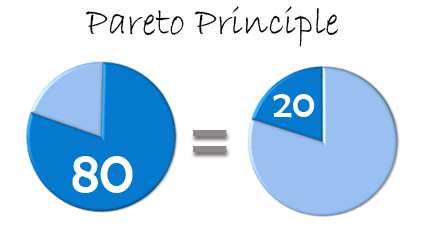Have you heard of the 80 20 rule? Well, it’s official name is the Pareto Principle, named after the economist Vilfredo Pareto. The principle has been used successfully by Microsoft, 37signals and Tim Feriss to allocate effort for maximum results.
So what’s the go? In an ideal World we’d like to believe that effort and results are equally rewarded in a fair exchange. 1 unit of effort should reap 1 unit of results. But this romantic view does not match up with reality. Effort and reward have a non-linear relationship. Sometimes we can plug away at a task for hours and get minimal results, other times results seem to flow after only a short period of time. This can be frustrating. Welcome to the world of the Pareto Principle.
Back in 1906, Vilfredo Pareto noticed that 80% of Italy’s land was owned by 20% of the population. He also noted that 80% of the peas in his garden came from 20% of his pea pods.
Later, the economist Joseph M. Juran took Pareto’s work and started to apply his logic to management theories far broader than Pareto’s original 80 20 rule construct. Juran pretty much breathed life into the Pareto Principle and was responsible for its worldwide adoption and recognition as we know it today. In keeping with the principle, you could say that Juran put in 80% of the effort to promote and teach the principle, but he himself only received only 20% of the spoils. It’s a cruel world isn’t it?
Pareto Principle Examples
- 80% of your profits come from 20% of your customers
- 80% of your results come from 20% of your employees
- 80% of your sales come from 20% of your items
- 80% of the time you are using 20% of an applications features
- 80% of the time you spend fixing problems are caused by only 20% of the problems
- 80% of the custard scroll is just pastry. The other 20% is custard
Well, I made up that last one. Truth be known the 80 20 rule is probably closer to 95-5 for that one. They just keep reducing the amount of custard don’t they?
So How Can I Use the 80 20 Rule?
Bear in mind that the Pareto Principle is a guiding principle, it’s not an absolute truth. That means it would be silly to believe that the principle holds true across every case. The premise of the principle should make you evaluate what you are doing and have you focus your effort to get the most bang for your buck.
By understanding that you may be allocating 80% of your time towards 20% of your clients, you should begin to reevaluate your priorities and whether all your client relationships offer the same value. Maintaining problem clients can in fact be costing you money (not to mention emotional stress). Perhaps under-servicing them or tactfully recommending them to a competitor may free up your time for other more profitable ventures?
The Pareto Principle should teach you to:
- Concentrate on servicing (and acquiring) your most profitable customers
- Concentrate your efforts on your most heavily used services
- Concentrate your efforts on improving your most widely reported problems
By focusing on the low hanging fruit, you’re better placed to receive results and rewards higher than the effort you need to use. Now that’s smart business.
Growing your small business,
David Moloney
sbp.strongerbranch.com
GET FREE INSTANT ACCESS TO THESE
THREE ESSENTIAL SMALL BUSINESS RESOURCES
(To help you maximise your business)

15 Recommended Downloads for Small Business Owners

10 Website Mistakes That Cost You Sales

How to Get More Customers Contacting You Automatically



A good reminder David, thank you. Loved the custard scroll analogy.
.-= Compost King´s last blog ..Anaerobic Composting Methods =-.
…and 80% of comments come from 20% of readers!
The 80/20 rule is all around us – every day. Thanks for introducing me to it’s real name – the Pareto Principle
.-= Jan Littlehales´s last blog ..Baked Fish with Tomato Sauce – in Ten Minutes =-.
Another great post David. You are hitting the nail on the head for me. I love the 80:20 rule. It has made a big difference in my life and it is nice to get a wee reminder. The only dissapointment I have had with this rule was when I found that a local business applied the 80:20 rule to their linen business, which meant that in my old margaret river accommodation business we found we were now washing our own linen as we were not one of the linen companies 20% making them all the money. This was a great move for the business and we understood why they applied the Pareto Principal.
.-= Benji – Passionate about Margaret River´s last blog ..Augusta River Festival 2011 =-.
Yes you are right,about the 80/20 rule. Remember though, action is the key to any business.
.-= Marguerite Dennert´s last blog .. =-.